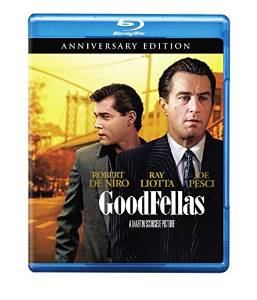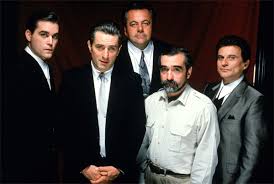
Goodfellas at 25
by Rob Levy
Despite recently turning 25 Goodfellas, a film universally praised as a crowning achievement in the mob movie genre, was initially dismissed as the odd little brother of Mafioso films. But with the passage of time it is consistently hailed as one of the greatest films ever made.
Since it’s release in 1990, it has pulled its weight. Nominated for six Academy Awards and included in the National Film Registry in 2000, the movie has aged like fine wine. It’s not a pretty film, its ugly and pugnacious and unquestionably a classic.
At a time when every multiplex is filled with wannabee hoodlums in nice suits and scruffy beards, Goodfellas serves as a stylish reminder of what good storytelling, resplendent with ruthless brutality, misogynistic male characters and a soundtrack that frames each scene, should be.
One of the best things about the pantheon of Scorsese films is his meticulous attention to casting and a good screenplay. Here the script was developed organically by having the three principals, Robert DeNiro, Joe Pesci and Ray Liotta, freestyle their lines during rehearsal and then adding the polished dialogue into the script afterward. The result is a terrific on-screen chemistry that most directors today would kill for. The seemingly effortless output from this triumvirate propels the audience through the violent world they’ve created.

Based on Nicholas Pileggi’s book, Wiseguy, and co-written with the director, the film spans 1955-1980, a time when Henry Hill (Liotta) started small but got bigger as a member of the Lucchese crime family. Hill’s career begins as a small time hooligan parking Cadillacs and running errands for a Brooklyn capo named Paulie Cicero. Growing from adolescence into adulthood, Hill evolves into a powerful gangster with his own drug network and lackeys.
As he ascends in the underworld Hill develops close ties with his mentor, Jimmy “The Gent” Conway (DeNiro) and the combustible Tommy DeVito (Pesci). Conway and Hill share the common bond of not being full-blooded Italian, which serves as a motivator for each man as they rise through the ranks of the Family.
Hill’s first big score was the 1967 Air France heist where he and his cronies helped themselves to $60,000 in cash from the airline’s cargo terminal at JFK. This caper not only cemented Hill and his friends status in the ranks it also was the germination of his disastrous tendency of operating behind Paulie’s back.
Things begin to go south three years later when Tommy, believing member of the Gambino family insulted him, kills him in a restaurant, forcing the three thugs to cover up the murder. Later that year Hill and Conway are dispatched to collect a debt in Florida. Unbeknownst to them the man they roughed up has a sister working for the FBI. As a result they are arrested and sent to the slammer. Forced to find innovate new ways to support his family from the inside, Henry begins to deal narcotics. Business is so good that upon his release he brings Jimmy and Tommy into the fold. The money brought in from this enterprise rewards them with lucrative returns, seemingly setting them up for life.
Hungry for more, the three of them get a crew together and execute the infamous Lufthansa heist, a robbery that yields nearly six million in jewels and cash. However, as Scorsese depicts with agonizing precision, this moment is not only their apex of success, but also the pivotal point at which things begin to unravel as the walls of death, greed and paranoia close in, creating a bloody final act which cements Goodfellas stature as a classic.
When you peel away its cold, brutal and callous shell the film is a unique study in friendship, loyalty and betrayal that serves as a poignant reminder of how deeply Mafia culture is engrained in our popular psyche. While many contemporary mob films emphasize the opulence of the lifestyle, this film flips that, infusing the genre with a fully rounded blue-collar ethos which other gangster flicks seldom flesh out with such vivid detail.
Joe Pesci is a force of nature. His best Supporting Actor Oscar winner turn is unnerving, funny and raw. You appreciate his sadistic performance even more when you consider the fact that he also made Home Alone that same year.
Henry is never on safe footing. Liotta presents him as a precariously stark and edgy character filled with ambitious and emotionally tortured. Liotta’s eyes and body movements say just as much as his spoken words, layering his creation with a pitch perfect melancholy, enabling him to completely immerse himself in the role.
By contrast DeNiro’s cerebral Conway accentuates the merciless life he leads by running roughshod over everyone in his path. DeNiro gives him an ambivalent swagger that is truly terrifying.
Visually Goodfellas pushes cinema into new territory. Despite taking eight takes, his use of one long shot of Henry walking into the Copacabana was an innovative flourish at the time that has become a staple of contemporary film.
With The Godfather ruling as the boss of all mobster movies, another of Martin Scorsese’s films, Goodfellas, has spent the past two and a half decades brilliantly reminding us of just how dangerous the muscle, hustle and bustle of the life truly is.
Goodfellas has been released in a special 25th Anniversary DVD and Blu Ray. In addition to the film there are two audio commentaries, a making of featurette and a short film on the legacy of Goodfellas. There is a spiffy new documentary about the experience of working the acclaimed director, featuring interviews with Robert DeNiro, Leonardo DiCaprio, Harvey Keitel, Ray Liotta, Jack Nicholson and Joe Pesci. ◼












